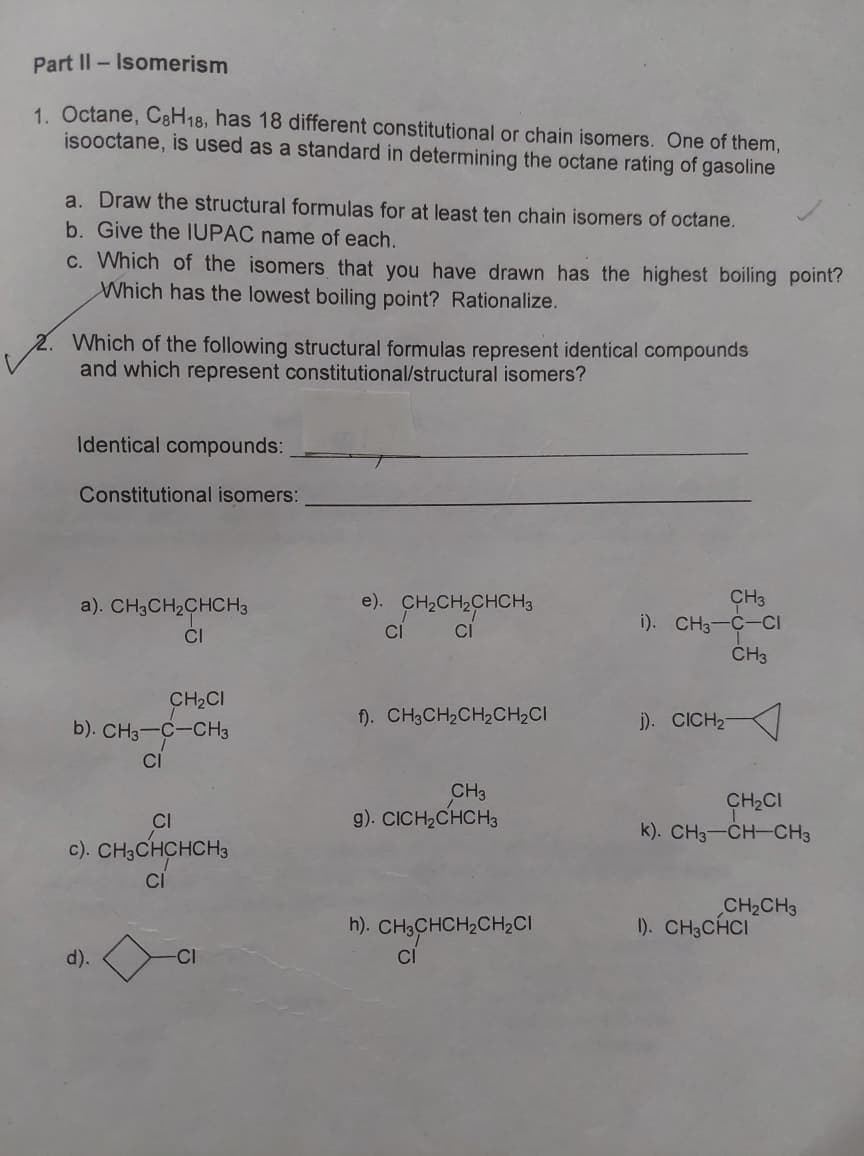1. Octane, C8H18, has 18 different constitutional or chain isomers. One of them, isooctane, is used as a standard in determining the octane rating of gasoline a. Draw the structural formulas for at least ten chain isomers of octane. b. Give the IUPAC name of each. C. Which of the isomers that you have drawn has the highest boiling point? Which has the lowest boiling point? Rationalize.
1. Octane, C8H18, has 18 different constitutional or chain isomers. One of them, isooctane, is used as a standard in determining the octane rating of gasoline a. Draw the structural formulas for at least ten chain isomers of octane. b. Give the IUPAC name of each. C. Which of the isomers that you have drawn has the highest boiling point? Which has the lowest boiling point? Rationalize.
Chemistry: The Molecular Science
5th Edition
ISBN:9781285199047
Author:John W. Moore, Conrad L. Stanitski
Publisher:John W. Moore, Conrad L. Stanitski
Chapter2: Chemical Compounds
Section2.9: Organic Molecular Compounds
Problem 2.12E
Related questions
Question
100%

Transcribed Image Text:Part II - Isomerism
1. Octane, C8H18, has 18 different constitutional or chain isomers. One of them,
isooctane, is used as a standard in determining the octane rating of gasoline
a. Draw the structural formulas for at least ten chain isomers of octane.
b. Give the IUPAC name of each.
c. Which of the isomers that you have drawn has the highest boiling point?
Which has the lowest boiling point? Rationalize.
2. Which of the following structural formulas represent identical compounds
and which represent constitutional/structural isomers?
Identical compounds:
Constitutional isomers:
CH3
i). CH3-C-CI
ČH3
a). CH3CH2CHCH3
e). CH2CH2CHCH3
CI
CI
CI
CH,CI
b). CH3-C-CH3
f). CH3CH2CH2CH,CI
j). CICH2
CI
CH3
g). CICH,CHCH3
CH2CI
k). CH3-CH-CH3
CI
c). CH3CHCHCH3
CH2CH3
1). CH3CHCI
h). CH3CHCH2CH2CI
CI
d).
-CI
Expert Solution
This question has been solved!
Explore an expertly crafted, step-by-step solution for a thorough understanding of key concepts.
This is a popular solution!
Trending now
This is a popular solution!
Step by step
Solved in 5 steps with 2 images

Knowledge Booster
Learn more about
Need a deep-dive on the concept behind this application? Look no further. Learn more about this topic, chemistry and related others by exploring similar questions and additional content below.Recommended textbooks for you

Chemistry: The Molecular Science
Chemistry
ISBN:
9781285199047
Author:
John W. Moore, Conrad L. Stanitski
Publisher:
Cengage Learning


Chemistry
Chemistry
ISBN:
9781305957404
Author:
Steven S. Zumdahl, Susan A. Zumdahl, Donald J. DeCoste
Publisher:
Cengage Learning

Chemistry: The Molecular Science
Chemistry
ISBN:
9781285199047
Author:
John W. Moore, Conrad L. Stanitski
Publisher:
Cengage Learning


Chemistry
Chemistry
ISBN:
9781305957404
Author:
Steven S. Zumdahl, Susan A. Zumdahl, Donald J. DeCoste
Publisher:
Cengage Learning

Chemistry: An Atoms First Approach
Chemistry
ISBN:
9781305079243
Author:
Steven S. Zumdahl, Susan A. Zumdahl
Publisher:
Cengage Learning

Introductory Chemistry: A Foundation
Chemistry
ISBN:
9781337399425
Author:
Steven S. Zumdahl, Donald J. DeCoste
Publisher:
Cengage Learning

Chemistry & Chemical Reactivity
Chemistry
ISBN:
9781337399074
Author:
John C. Kotz, Paul M. Treichel, John Townsend, David Treichel
Publisher:
Cengage Learning